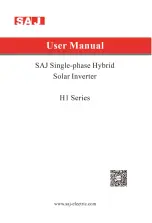
MS - SOUND decoders MS440 to MS990 and MN - NON-SOUND decoders MN170 to MN340 Page 31
CV
Denomination
Range
Default Description
#53
slow speed
0 - 255
70
Internal speed steps for the ABC slow speed
#100
Current asymmetry
voltage
(from SW version 4.227)
0 - 255
The CV
#100 delivers when read out via PoM (=Prog
On the Main, =OP Prog Mode) the asymmetry voltage
measured AT THE TIME in tenths of a volt. For the
read CV values of CV
#100 the following applies:
[…]
2 = 0.2
V Asymmetry right track higher voltage
1 = 0.1
V Asymmetry right track higher voltage
0 = perfectly symmetrical signal
255= 0.1
V Asymmetry left track higher voltage
254= 0.2
V Asymmetry left track higher voltage
[…]
The result is rounded to tenths of a volt, therefore the
last bit may "flicker" a bit (e.g. with a measured rail volt-
age asymmetry of e.g. 1.44 V the CV sometimes re-
turns 14 and sometimes 15 as CV value).
#101
Correction factor for CV
#100
(from SW version 4.227)
0 - 255
0
CV
#101 can be used to define a correction factor in one
of the two directions (only necessary for models with 6pol
NEM 651 interface, where the consumers load one of the
two rails).
#134
Asymmetry threshold
for the
"Asymmetric
DCC - Signal"
(ABC)
1 - 14,
101 - 114,
201 - 214
=
0.1
– 1.4 V
106
Hundredths digit: smoothing time constant; through this
the asymmetry detection can be made more reliable
(thus slower) or faster.
= 0: fast detection (but higher risk of errors, e.g.: unreli-
able stopping).
= 1: medium-fast detection (approx. 0.5 sec), already
fairly safe (default).
= 2: slow detection (approx. 1 sec), very safe.
tens and ones digit: asymmetry threshold in tenths of a
volt. From this voltage difference between the half-waves
of the DCC signal, the asymmetry is to be registered as
such, and the stopping of the vehicle is is initiated.
= 106 (default) therefore means 0.6 V asymmetry thresh-
old. This normally seems to be an appropriate value; cor-
responding to the typical generation of the asymmetry by
a circuit consisting of a total of 4 diodes.
#193
ABC - commuting
with stopping times in
reverse loops
0,
1 - 255
0
= 0: no commuting on ABC basis
= 1 - 255: Stopping period (in sec) in the ABC stopping
(=turnaround) sections at the end of the commuting
distance.
#194
ABC - commuting
with additional
pit stops
0,
1 - 254,
255
0
Only as commuting if CV #193 = 1 - 255
= 0: Commuting without pit stops (see above)
= 1 - 254: Commuting with pit stops
(terminal loops by ABC slow-speed sections,
pit stops defined by ABC stopping sections)
Stopping period (in sec) in the pit stops
= 255: as above but permanent stop in pit stops
(until stop is cancelled).
CV
Denomination
Range
Default Description
#29
Basic Configuration
0 - 63
14 =
0000 1
1
10
so
Bit 2 = 1
When using DC brake sections, the automatic switch-
over to analog operation must be switched off.
So that settings in CV #27, bits 4 and 5 are effective:
CV #29, Bit 2 = 0
(e.g. CV #29 = 6, instead of the default value 14)
Bit 0 - Directional behavior
Bit 1 - Number of speed steps
Bit 2 - Automatic switching to analog operation
0 = off, 1 = switched on
Bit 3 - RailCom (bi-directional communication)
Bit 5 - Selection of vehicle address (DCC)
#27
Position-dependent
Stopping
(“before a red signal”)
or driving slowly
by
“asymmetrical DCC sig-
nal“ (“Lenz ABC“)
See chapter
or
“ZIMO HLU”
or
DC brake sections
(“Märklin brake section”)
0 =
ABC not
active,
HLU
active,
other
brake
sections
not active
Bit 0 and Bit 1 = 0: ABC not activated; no stopping
Bit 0 = 1: Stops are initiated if the voltage in the right
rail (in direction of travel) is higher than in the left rail.
This (CV #27 = 1) is the usual ABC application)
Bit 1 = 1: ABC stops are initiated if the voltage in the left
rail (in direction of travel) is higher than in the right rail.
If bit 0 or bit 1 =1 (only one of the two bits is set):
Stopping is directional, i.e. only in direction of travel to
the signal, travelling in opposite direction has no effect.
Bit 0 and Bit 1 = 1: Stops are independent of direction
of travel. See chapter “3.10 Stop in front of a red
signal and driving slowly by
Bit 4 - DC braking section, if polarity is reversed
0 = disabled 1 = enabled
Bit 5 - DC braking section, if polarity
is equal to direction of travel
0 = disabled 1 = enabled
Bit 4 and bit 5 = 1: stopping when
DC voltage (e.g. by a diode) independent
of the polarity (“Märklin brake section”)
Summary of Contents for MS450
Page 5: ...MS SOUND decoders MS440 to MS990 and MN NON SOUND decoders MN170 to MN340 Page 5...
Page 61: ...MS SOUND decoders MS440 to MS990 and MN NON SOUND decoders MN170 to MN340 Page 61...
Page 85: ...MS SOUND decoders MS440 to MS990 and MN NON SOUND decoders MN170 to MN340 Page 85...
Page 87: ...MS SOUND decoders MS440 to MS990 and MN NON SOUND decoders MN170 to MN340 Page 87...
Page 88: ...Page88 MS SOUND decoders MS450 to MS990 ZIMO Elektronik GmbH Sch nbrunner Str 188 A 1120 Wien...
















































